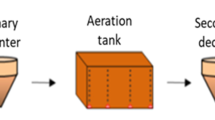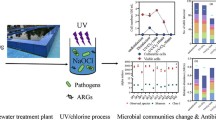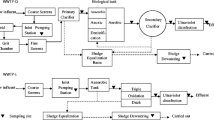Abstract
Antibiotics and antibiotic resistance genes have shown to be omnipresent in the environment. In this study, we investigated the effect of vancomycin (VA) on denitrifying bacteria in river sediments of a Waste Water Treatment Plant, receiving both domestic and hospital waste. We exposed these sediments continuously in flow-through reactors to different VA concentrations under denitrifying conditions (nitrate addition and anoxia) in order to determine potential nitrate reduction rates and changes in sedimentary microbial community structures. The presence of VA had no effect on sedimentary nitrate reduction rates at environmental concentrations, whereas a change in bacterial (16S rDNA) and denitrifying (nosZ) community structures was observed (determined by polymerase chain reaction–denaturing gradient gel electrophoresis). The bacterial and denitrifying community structure within the sediment changed upon VA exposure indicating a selection of a non-susceptible VA population.



Similar content being viewed by others
References
Ahmad M, Vithanage M, Kim K, et al (2014) Inhibitory effect of veterinary antibiotics on denitrification in groundwater: A microcosm approach. Sci. World J. 2014 (in press)
Baquero F, Martinez JL, Canton R (2008) Antibiotics and antibiotic resistance in water environments. Curr Opin Biotech 19:260–265
Brown KD, Kulis J, Thomson B, Chapman TH, Mawhinney DB (2006) Occurrence of antibiotics in hospital, residential, and dairy, effluent, municipal wastewater, and the Rio Grande in New Mexico. Sci Total Environ 366:772–783
Cheneby D, Philippot L, Hartmann A, Henault C, Germon JC (2000) 16S rDNA analysis for characterization of denitrifying bacteria isolated from three agricultural soils. FEMS Microbiol Ecol 34:121–128
Costanzo SD, Murby J, Bates J (2005) Ecosystem response to antibiotics entering the aquatic environment. Mar Pollut Bull 51:218–223
Davies J, Spiegelman GB, Yim G (2006) The world of subinhibitory antibiotic concentrations. Curr Opin Microbiol 9:445–453
Ding C, He J (2010) Effect of antibiotics in the environment on microbial populations. Appl Microbiol Biotechnol 87:925–941
Dinh MQT (2012) Transfert et comportements d’antibiotiques a l’echelle du bassin elementaire. PhD thesis, L’Ecole Pratique des Hautes Etudes, Universite Pierre et Marie Curie
Dinh T, Alliot F, Moreau-Guigon E, Eurin J, Chevreuil M, Labadie P (2011) Measurement of trace levels of antibiotics in river water using on-line enrichment and triple-quadrupole LC–MS/MS. Talanta 85:1238–1245
Dolliver H, Gupta S, Noll S (2008) Antibiotic degradation during manure composting. J Environ Qual 37:1245–1253
Guardabassi L, Perichon B, van Heijenoort J, Blanot D, Courvalin P (2005) Glycopeptide resistance vanA operons in Paenibacillus strains isolated from soil. Antimicrob Agents Chemother 49:4227–4233
Gullberg E, Cao S, Berg OG, Ilback C, Sandegren L, Hughes D, Andersson DI (2011) Selection of resistant bacteria at very low antibiotic concentrations. Plos Pathog 7
Hammesfahr U, Heuer H, Manzke B, Smalla K, Thiele-Bruhn S (2008) Impact of the antibiotic Sulfadiazine and pig manure on the microbial community structure in agricultural soils. Soil Biol Biochem 40:1583–1591
Hernando MD, Mezcua M, Fernandez-Alba AR, Barcelo D (2006) Environmental risk assessment of pharmaceutical residues in wastewater effluents, surface waters and sediments. Talanta 69:334
Jones CM, Welsh A, Throback IN, Dorsch P, Bakken LR, Hallin S (2011) Phenotypic and genotypic heterogeneity among closely related soil-borne N2- and N2O-producing Bacillus isolates harboring the nosZ gene. FEMS Microbiol Ecol 76:541–552
Kleineidam K, Sharma S, Kotzerke A, Heuer H, Thiele-Bruhn S, Smalla K, Wilke BM, Schloter M (2010) Effect of Sulfadiazine on abundance and diversity of denitrifying bacteria by determining nirK and nirS genes in two arable soils. Microbial Ecol 60:703–707
Kloos K, Mergel A, Rosch C, Bothe H (2001) Denitrification within the genus Azospirillum and other associative bacteria. Aust J Plant Physiol 28:991–998
Kohanski MA, DePristo MA, Collins JJ (2010) Sublethal antibiotic treatment leads to multidrug resistance via radical-induced mutagenesis. Mol Cell 37:311–320
Kotzerke A, Sharma S, Schauss K, Heuer H, Thiele-Bruhn S, Smalla K, Wilke BM, Schloter M (2008) Alterations in soil microbial activity and N-transformation processes due to Sulfadiazine loads in pig-manure. Environ Pollut 153:315–322
Kümmerer K (2009) Antibiotics in the aquatic environment—a review - part I. Chemosphere 75:417–434
Laverman AM, Van Cappellen P, van Rotterdam-Los D, Pallud C, Abell J (2006) Potential rates and pathways of microbial nitrate reduction in coastal sediments. FEMS Microbiol Ecol 58:179–192
Lebreton F, Depardieu F, Bourdon N et al (2011) D-Ala-D-Ser VanN-type transferable vancomycin resistance in Enterococcus faecium. Antimicrob Agents Chemother 55:4606–4612
Li B, Zhang T (2011) Mass flows and removal of antibiotics in two municipal wastewater treatment plants. Chemosphere 83:1284–1289
Muyzer G, de Waal EC, Uitterlinden AG (1993) Profiling of complex microbial populations by denaturing gradient gel electrophoresis analysis of polymerase chain reaction-amplified genes encoding for 16S rRNA. Appl Environ Microbiol 59:695–700
Nödler K, Licha T, Barbieri M, Pérez S (2012) Evidence for the microbially mediated abiotic formation of reversible and non-reversible sulfamethoxazole transformation products during denitrification. Water Res 46:2131–2139
Oberle K, Capdeville MJ, Berthe T, Budzinski H, Petit F (2012) Evidence for a complex relationship between antibiotics and antibiotic-resistant Escherichia coli: from medical center patients to a receiving environment. Environ Sci Technol 46:1859–1868
Ollivier J, Kleineidam K, Reichel R et al (2010) Effect of sulfadiazine-contaminated pig manure on the abundances of genes and transcripts involved in nitrogen transformation in the root-rhizosphere complexes of maize and clover. Appl Environ Microbiol 76:7903–7909
Passerat J, Tamtam F, Le Bot B, Eurin J, Chevreuil M, Servais P (2010) Rejets hospitaliers d’antibiotiques et de bactéries fécales antibiorésistantes dans les rivières du bassin de la Seine. Eur J Water Qual 41:1–13
Philippot L (2002) Denitrifying genes in bacterial and Archaeal genomes. BBA-Gene Struct Expr 1577:355–376
Rizzo L, Manaia C, Merlin C, Schwartz T, Dagot C, Ploy MC, Michael I, Fatta-Kassinos D (2013) Urban wastewater treatment plants as hotspots for antibiotic resistant bacteria and genes spread into the environment: a review. Sci Total Environ 447:345–360
Roose-Amsaleg C, Yan C, Hong AM, Laverman AM (2013) Chronic exposure of river sediments to environmentally relevant levels of tetracycline affects bacterial communities but not denitrification rates. Ecotoxicology 22:1467–1478
Santos L, Araujo AN, Fachini A, Pena A, Delerue-Matos C, Montenegro M (2010) Ecotoxicological aspects related to the presence of pharmaceuticals in the aquatic environment. J Hazard Mater 175:45–95
Scala DJ, Kerkhof LJ (1998) Nitrous oxide reductase (nosZ) gene-specific PCR primers for detection of denitrifiers and three nosZ genes from marine sediments. FEMS Microbiol Lett 162:61–68
Tamtam F, Mercier F, Le Bot B, Eurin J, Dinh QT, Clement M, Chevreuil M (2008) Occurrence and fate of antibiotics in the Seine River in various hydrological conditions. Sci Total Environ 393:84–95
Tamtam F, Le Bot B, Dinh T, Mompelat S, Eurin J, Chevreuil M, Bonte P, Mouchel JM, Ayrault S (2011) A 50-year record of Quinolone and Sulphonamide antimicrobial agents in Seine River sediments. J Soil Sed 11:852–859
Thiele-Bruhn S (2003) Pharmaceutical antibiotic compounds in soils—a review. J Plant Nutr Soil Sci 166:145–167
Throbäck IN, Enwall K, Jarvis A, Hallin S (2004) Reassessing PCR primers targeting nirS, nirK and nosZ genes for community surveys of denitrifying bacteria with DGGE. FEMS Microbiol Ecol 49:401–417
Tschech A, Pfennig N (1984) Growth yield increase linked to caffeate reduction in Acetobacterium woodii. Arch Microbiol 137:163–167
Underwood JC, Harvey RW, Metge DW, Repert DA, Baumgartner LK, Smith RL, Roane TM, Barber LB (2011) Effects of the antimicrobial Sulfamethoxazole on groundwater bacterial enrichment. Environ Sci Technol 45:3096–3101
Wright GD (2003) Mechanisms of resistance to antibiotics. Curr Opin Chem Biol 7:563–569
Yan C, Dinh QT, Chevreuil M et al (2013) The effect of environmental and therapeutic concentrations of antibiotics on nitrate reduction rates in river sediment. Water Res 47:3654–3662
Zuccato E, Castiglioni S, Bagnati R, Melis M, Fanelli R (2010) Source, occurrence and fate of antibiotics in the Italian aquatic environment. J Haz Mater 179:1042–1048
Acknowledgments
The authors like to thank Benjamin Mercier, Olivier Tronquart for assistance in the field, Tuc Dinh, Fabrice Alliot for the help during antibiotic analysis. This work was financed by the Region Ile de France (RD2S project 2009-07), the program Piren Seine and EC2CO FLASH CNRS.
Author information
Authors and Affiliations
Corresponding author
Additional information
Responsible editor: Philippe Garrigues
Rights and permissions
About this article
Cite this article
Laverman, A.M., Cazier, T., Yan, C. et al. Exposure to vancomycin causes a shift in the microbial community structure without affecting nitrate reduction rates in river sediments. Environ Sci Pollut Res 22, 13702–13709 (2015). https://doi.org/10.1007/s11356-015-4159-6
Received:
Accepted:
Published:
Issue Date:
DOI: https://doi.org/10.1007/s11356-015-4159-6




